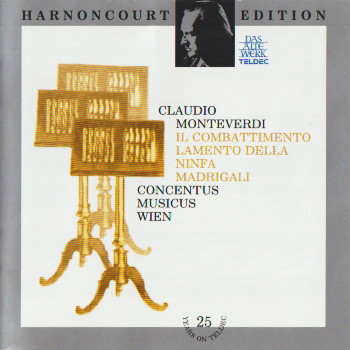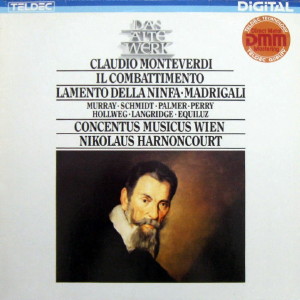 |
1 CD -
Teldec 8.43054 XH (c) 1989
|
 |
| 1 LP -
Tedec 6.43054 AZ (p) 1984 |
|
| NIKOLAUS HARNONCOURT - 25 Years
on TELDEC |
|
|
|
|
|
|
|
| Claudio
Monteverdi (1567-1643) |
"Madrigali
guerrieri, et amorosi..." Libro
ottavo, 1638 |
|
|
|
|
|
|
|
|
|
Combattimento
di Tancredi e Clorianda - aus
"Canti Guerrieri" |
|
21' 12" |
A1
|
|
Trudeliese Schmidt, Clorianda |
|
|
|
|
Kurt
Equiluz, Tancredi |
|
|
|
|
Werner
Hollweg, Testo |
|
|
|
|
Ogni
amante e guerrier - aus
"Canti Guerrieri" |
|
16' 30" |
B1 |
|
Werner
Hollweg, Tenore |
|
|
|
|
Philip
Langridge, Tenore |
|
|
|
|
Hans
Franzen, Basso |
|
|
|
|
Mentre
vaga angioletta - aus "Canti
amorosi" |
|
10' 17" |
B2 |
|
Jenet
Perry, Soprano |
|
|
|
|
Ann
Murray, Soprano |
|
|
|
|
Felicity
Palmer, Soprano |
|
|
|
|
Anne-Marie
Mühle, Soprano |
|
|
|
|
Lamento
della Ninfa - aus "Canti amorosi" |
|
5' 24" |
A2 |
|
Ann
Murray, Canto |
|
|
|
|
Philip
Langridge, Tenore |
|
|
|
|
Kurt
Equiluz, Tenore |
|
|
|
|
Rudolf
Hartmann, Basso |
|
|
|
|
|
|
|
|
| CONCENTUS MUSICUS
WIEN (mit Originainstrumenten) |
|
| Nikolaus
HARNONCOURT, Leitung |
|
|
|
|
|
Luogo
e data di registrazione |
|
Casino
Zögernitz, Vienna (Austria) -
febbraio 1984 |
|
|
Registrazione:
live / studio |
|
studio |
|
|
Producer
|
|
- |
|
|
Edizione CD |
|
TELDEC
- 8.43054 XH (243 036-2) - (1 CD -
durata 53' 54") - (c) 1989 - DDD |
|
|
Originale LP
|
|
TELDEC
- 6.43054 AZ - (1 LP - durata 53'
54") - (p) 1984 - Digitale |
|
|
Note |
|
-
|
|
|
|
|
|
In the 16th
and early 17th century
particularly in Italy and then
in England, the madrigal was the
most important musical form,
music being an integral part of
contemporary court life. At the
same time, the extent of its
popularity and its lack of
restrictive link with liturgical
convention made it an important
vehicle for experimental
composition and new ideas.
Claudio Monteverdi,
admiringly called by his
contemporaries
“oracolo della
musica”, exerted
a decisive influence
on the whole course of musical
history. A “conservative
revolutionary”, like all great
revolutionaries, gradually he
brought about a change in
European musical style during a
long continual process, a
process of change particularly
well demonstrated in his
nadrigal works. Monteverdi
occupied himself with the
madrigal well nigh all his life:
in 1587, when he was twenty, he
published his first book of
madrigals, five years before his
death his eighth book
was published.
In his Fifth Book of Madrigals
(1605) Monteverdi introduced the
use of an accompanying basso
continuo. In defending this
innovation in his preface to the
book, against the attacks of
critical protagonists of pure
counterpoint, he made this now
famous statement: “l’oratione
sia padrona del armonia e non
serva" (“The text should be the
master, not the
servant of music”). Fully aware
of its modernity he named his
new way of writing Seconda
prattica (“second way”), as
opposed to the older Prima
prattica (“first Way”) - the
school of strict counterpoint.
Two years later, in 1607, he
composed his first dramatic
work, “Orfeo”. Through the great
variety of forms it contains,
both structurally and musically
this work surpasses
anything previously written in
the older declarnatory
style of the Florentine
Camerata, and obviously owes
much to the preceding work done
in his madrigals. In his
Sixth Book of Madrigals (1614),
Monteverdi for the first time
abandoned the traditional
five-part structure of the
madrigal, trying out various
settings, sometimes in a
soloistic-virtuoso style (stile
concertato).
The Madrigal Book VII and
VIII are of particular value
because they disclose the
pattern of development of
Monteverdi's dramatic style.
Unfortunately, through a
turn of fate, of the other
numerous dramatic works written
between “Orfeo” and the two late
Venetian operas “Il ritorno
d’Ulisse in patria” (1641) and
“L’Incoronazione di Poppea”
(1642) little is now extant.
The Eighth Book of Madrigals
appeared in 1638, during the
Thirty Years’ War, under the
title of “Madrigali
guerrieri, et amorosi / con
alcuni opusculi in genere
rappresentativo, che saranno per
brevi Episodii fra i canti senza
gesto” and dedicated to Emperor
Ferdinand III. By “canti
senza gesto” are meant the
“non-gestic” madrigals of the
collection. Of the pieces
composed “in genere
rappresentativo” (“in dramatic
style”) should be mentioned
particularly the “Combattimento
di Tancredi et Clorinda”. The
“Combattimento” is the setting
of a piece of Torquato Tasso’s
epic poem “Gerusalemme liberata”
(verses from Canto
XII). Its completely
unschematic construction fits it
into no particular musical
category, though it is sometimes
called a “scenic madrigal” or
“scenic cantata”, and it has not
etablished any new form in
itself. lt is, however, one of
Monteverdi's most famous
works and has, through its
subtle musical-pictorial setting
of the words and dramatic
effects, retained its ability to
achieve an immediate impact even
today. To his Eighth Book of
Madrigals Monteverdi added a
lenghty introduction in which he
clearly defines his position
regarding; the works published.
|
|

